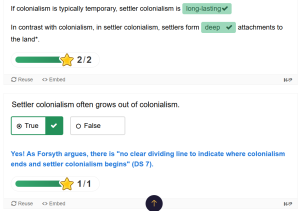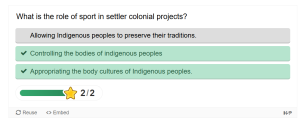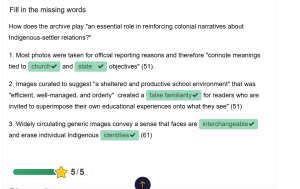4
These are difficult stories. We bear witness in this chapter to the role of sport in furthering the settler colonial projects throughout Turtle Island. Here are some supports to access in the community and from a distance:
First Peoples House of Learning Cultural Support & Counselling
Niijkiwendidaa Anishnaabekwag Services Circle (Counselling & Healing Services for Indigenous Women & their Families) – 1-800-663-2696
Nogojiwanong Friendship Centre (705) 775-0387
Peterborough Community Counselling Resource Centre: (705) 742-4258
Hope for Wellness – Indigenous help line (online chat also available) – 1-855-242-3310
LGBT Youthline: askus@youthline.ca or text (647)694-4275
National Indian Residential School Crisis Line – 1-866-925-4419
Talk4Healing (a culturally-grounded helpline for Indigenous women):1-855-5544-HEAL
Section One: History
A) The Residential School System
Exercise 1: Notebook Prompt
We are asked to honour these stories with open hearts and open minds.
Which part of the chapter stood out to you? What were your feelings as you read it? (50 words)
| Reading about the games available to girls versus boys was challenging, especially when it was noted that a principal had let girls skate, play football, basketball, etc and they had enjoyed it. Additionally, the fact that one principal thanked other schools for coming to play against the boys, as if they were completing an act of charity is disturbing.
|
B) Keywords
Exercise 2: Notebook Prompt
Briefly define (point form is fine) one of the keywords in the padlet (may be one that you added yourself).
| Indigenous body culture is the ways of belief and traditions connected to the body. These concepts include body modifications to express spirituality, such as body painting/face painting and tattoos. The body is considered sacred, and ceremonies honour this. Dancing is also an aspect of this, which can further develop a relationship to the land.
|
C) Settler Colonialism
Exercise 3: Complete the Activities


Exercise 4: Notebook Prompt
Although we have discussed in this module how the colonial project sought to suppress Indigenous cultures, it is important to note that it also appropriates and adapts Indigenous cultures and “body movement practices” (75) as part of a larger endeavour to “make settlers Indigenous” (75).
What does this look like? (write 2 or 3 sentences)
| Historically, the appropriation and adaptation of Indigenous cultures has looked like the creation of media demonstrating a stereotypical scene. These images also linked settler ideas with concepts that were already created by Indigenous peoples. Recreating Indigenous cultures from a settler lens removes Indigenous peoples from the activity and conversations, further removing their identities – especially in sports like lacrosse and snowshoeing.
|
D) The Colonial Archive

Exercise 5: Complete the Activities
Section Two: Reconciliation
A) Reconciliation?
Exercise 6: Activity and Notebook Prompt
Visit the story called “The Skate” for an in-depth exploration of sport in the residential school system. At the bottom of the page you will see four questions to which you may respond by tweet, facebook message, or email:
How much freedom did you have to play as a child?
What values do we learn from different sports and games?
When residential staff took photos, what impression did they try to create?
Answer one of these questions (drawing on what you have learned in section one of this module or prior reading) and record it in your Notebook.
| Residential staff used photos as propaganda for residential schools, in an attempt to showcase that schools were a safe place children were growing and learning new skills. This matches with what we have already learned in the first section of this module about erasing Indigenous identity. In the images, children were not allowed to wear their own clothing, but instead had to look like they had assimilated and abandoned their culture.
|
B) Redefining Sport
B) Sport as Medicine
Exercise 7: Notebook Prompt
Make note of the many ways sport is considered medicine by the people interviewed in this video.
| Being able to speak their own language on the court was one of the only times children in residential schools were allowed to use this part of their culture. Using lacrosse, especially to reconnect with each other and the Creator, is important and valued. It was mentioned that some of the happiest moments throughout their time at residential school were when they were able to play sports. Today, generations later, Indigenous youth are still using sports to connect to their ancestors and feel immense pride at finding their place on teams.
|
C) Sport For development
Exercise 7: Notebook Prompt
What does Waneek Horn-Miller mean when she says that the government is “trying but still approaching Indigenous sport development in a very colonial way”?
| Waneek is explaining that the government does not understand how Indigenous people would like to work together to better solve barriers to advancing in sports. Instead of setting a prescribed solution, Waneek would like the government to better listen to what Indigenous communities need. I interpret this to mean that Waneek would like there to be more conversations instead of the government determining what is best for Indigenous people without including them in discussions. |
Exercise 8: Padlet Prompt
Add an image or brief comment reflecting some of “binding cultural symbols that constitute Canadian hockey discourse in Canada.” Record your responses in your Notebook as well.
|
I chose the hockey skate, to represent the sport, but I picked one with the maple leaf on it to demonstrate how enmeshed Canada is with hockey. The maple lead and hockey are almost synonymous with each other. |
Section Three: Decolonization
For this long prompt, I chose to review the actions that came from Call to Action 91. Action 91 called for officials and host countries of international sporting events (Olympics, Pan Am Games, Commonwealth Games) to ensure that Indigenous peoples’ territorial protocols are respected and local Indigenous communities are engaged in all aspects of planning and participating in events.
When determining host countries for events, domestically and internationally, Sport Canada includes this specific call to action so that other countries can understand it is a priority. While Sport Canada also includes this content in provincial and territorial government documents, it is specifically required for major event partners. I think this is extremely important as it forces major event partners to fully consider this initiative, broadening its reach and influence.
Financially, governmental support has been assigned to support an increase in offering culturally relevant sports programming, support the North American Indigenous Games team preparation and travel, and invest $1.6 million to add lacrosse to the 2025 Canada Summer Games. This week’s module fully demonstrated the impact of this sport and its importance. The government also agreed to support the hosting of the North American Indigenous Games and Indigenous sport leadership with culturally relevant sports programming.
Looking ahead, the Major Sport Event Coordination Group is actively working with event parties and Indigenous organizations to establish a baseline approach for following and measuring this Call to Action. This work has already begun, with Sport Canada consulting with every Host Society for the Canada Games to ensure they share capital projects being completed.
Communities and individuals can contribute to this Call to Action by holding the government and other sports organizations responsible for this goal. We need it to be known that, when engaging with Canada, this action is important, and we expect it to be followed.


